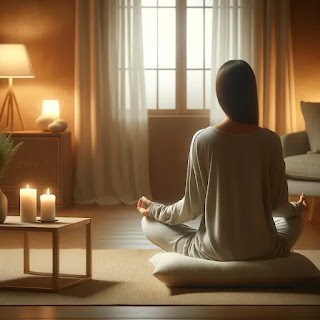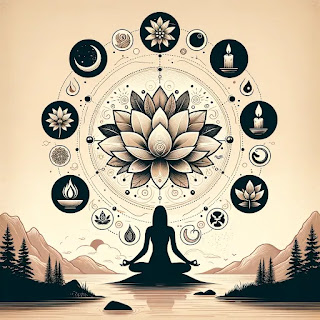How to Meditate with Candles
How to Meditate with Candles
Harnessing the Warm Glow for Enhanced Focus
In a world brimming with distractions, finding a moment for true peace often feels like a quest. Candle meditation, or Trataka, offers a gateway to this tranquility, emphasizing the simple act of focusing on a candle flame to sharpen mental clarity and promote a calming effect on the mind. This ancient practice not only helps individuals center their thoughts but also improves eye health and enhances concentration.
This technique serves as a foundational step for beginners in meditation, introducing them to the discipline required to meditate effectively while providing a focal point that is both literal and metaphorical. The flickering flame helps stabilize the gaze, train the eyes, and anchor the mind, setting the stage for deeper meditation experiences.

The Scientific Basis of Candlelight Meditation
Neurological Impacts of Focused Candle Gazing
Engaging in candle meditation, or specifically the practice of Trataka, activates unique neurological pathways. Studies show that focusing intently on the steady light of a candle flame enhances the brain’s ability to concentrate. This focus can reduce symptoms commonly associated with trouble focusing and significantly impact sleep quality by promoting relaxation before bedtime. Additionally, candle gazing meditation is known to activate the ajna chakra, leading to enhanced mental awareness and a deeper connection to one’s intuition and spirituality.
Psychological and Emotional Benefits of Candle Meditation
The repetitive nature of gazing at a candle flame has profound psychological benefits. Regular practitioners report a decrease in anxiety levels and a notable improvement in overall mental health. This form of meditation can also lead to enhanced emotional stability, helping individuals manage stress more effectively and maintain a calm demeanor in daily life. Historical texts like the hatha yoga pradipika highlight the significance of trataka, as a practice for mental and spiritual purification, further emphasizing its long-standing benefits for emotional well-being.
Visual Health through Focused Gazing
Focusing on a single object like a candle flame can also strengthen eye muscles. This practice can be particularly beneficial for combating the symptoms of eye diseases linked to screen fatigue. By regularly exercising the eyes in this manner, individuals can maintain better eye health and potentially reduce the severity of existing eye conditions.

How to Practice Candle Gazing Meditation (Trataka): A Detailed Guide
Preparing for Candle Meditation
Setting up for your meditation practice with candle gazing isn’t all that different than a simple meditation preparation. Whether you are practicing on a strict schedule or just as it feels right, getting started is as simple as making the decision to meditate and following through on the decision. That’s the hardest part!
From there it’s as simple as selecting the appropriate candle and setting up a conducive environment is crucial for effective Trataka practice. Use a candle with a clear, steady flame placed at eye level on a stable surface to minimize strain and maximize focus.
The Right Environment for Candle Meditation
Create a quiet space where you won’t be disturbed. The room should be dimly lit, allowing the candle flame to be the focal point of your gaze, which enhances concentration and minimizes external distractions.
Ensure that you have a safe environment for the flame and the mess. Having a wax catcher, no wind that could blow your flame out and any other distractions that may interfere with your practice.
The Meditation Process: Focusing on the Flame
Begin with a few deep breaths to center yourself before starting the meditation. The practice of Trataka involves focusing your gaze on the brightest part of the candle flame, usually just above the wick, and letting your eyes softly settle, keeping blinks to a minimum to maintain focus. This method of meditation induces a state of trance and profound insight by concentrating on a specific object.

Post-Meditation: Closing Your Session
Conclude your session by closing your eyes and taking deep breaths. Reflect on the experience, noticing any changes in your mental state or new feelings of clarity and calm.
Integrating Candle Meditation with Other Practices
Combining Breathing Techniques and Candle Meditation
Incorporate deep breaths and controlled breathing techniques before and after your candle meditation session to enhance the benefits of each practice.
Enhancing Yoga Practices with Candle Gazing
Use the candle as a point of focus during yoga to improve balance and concentration. Integrating these practices can enhance your overall meditation technique and provide a more holistic approach to wellness.
Candle Meditation and Guided Imagery
After a candle meditation session, transition into a guided imagery exercise, using the calm and focus achieved to visualize positive scenes and outcomes, further deepening the relaxation and meditation practice.

Selecting the Right Equipment for Candle Meditation
Choosing the Best Candles for Meditation When selecting candles for meditation, opt for those that provide a steady, calm flame. Natural beeswax or soy candles are preferred due to their non-toxic and environmentally friendly characteristics. Ensure the candle’s size is suitable for the duration of your meditation sessions.
Safety Measures for Practicing Candle Meditation It’s essential to prioritize safety when practicing candle meditation. Use a sturdy candle holder to prevent the candle from tipping over. Place the candle on a stable surface away from flammable materials and ensure the room is well-ventilated to avoid inhaling any potential smoke.
The Importance of a Comfortable Position Maintaining a comfortable position while meditating is crucial for focus and effectiveness. Ensure your seating allows for a straight posture with the candle placed at eye level to avoid straining the neck or eyes.
The Role of Candle Colors in Meditation
Choosing Candle Colors for Specific Intentions Colors have unique psychological impacts, and using colored candles in meditation can enhance specific emotional or energetic responses. For example:
- Blue candles are used to promote peace and calmness, ideal for evening meditation sessions that prepare you for sleep.
- Red candles help invigorate and stimulate energy, suitable for morning sessions when you need a boost to start your day.
- Green candles can encourage healing and balance, supporting overall well-being and harmony. Selecting a candle color that corresponds with your current needs can deepen your meditation practice and enhance its effects.

The Historical Significance of Candle Meditation Across Cultures
Candle Meditation in Various Traditions Candle meditation’s universal appeal is evident in its presence across multiple spiritual traditions. In Tibetan Buddhism, candles are lit as offerings to accompany prayers and meditations, believed to dispel spiritual darkness. In Christian contexts, candles are lit during prayer to symbolize Jesus Christ’s light in the world, reflecting a contemplative nature. Understanding these varied uses enriches the practice, offering a broader perspective on how universal the language of light is in spiritual practices.
Advanced Candle Meditation Techniques
Beyond Basic Gazing: Layering Techniques Once comfortable with simple candle gazing, practitioners can explore more complex techniques:
- Eyes Open/Eyes Closed Cycling: Alternating between gazing at the candle with open eyes and visualizing the flame with closed eyes can enhance mental imagery skills and deepen meditation.
- Chakra Visualization: Visualize the candle’s flame traveling to and illuminating various chakras or energy centers in the body, starting from the root up to the crown chakra, which can help in clearing and balancing these centers. Specifically, envisioning the candle’s flame illuminating the third eye chakra can enhance intuition and mental awareness, connecting you to a deeper sense of spirituality and internal strength.

Candle Meditation for Specific Outcomes
Using Candle Meditation to Address Specific Issues
This technique has been known to help those that struggle with the following:
- Insomnia: Focus on a soft blue or pink candle to soothe the mind before bedtime, aiding in quicker and deeper sleep.
- Anxiety: A green or lavender candle can help reduce feelings of anxiety, creating a peaceful state of mind.
- Focus: A yellow candle can stimulate mental clarity and concentration, especially beneficial during study or work.
Practical Tips for Beginners
Embarking on candle meditation requires some basic yet important tips:
- Session Length: Start with short 5-minute sessions, gradually increasing the duration as your concentration improves.
- Eye Comfort: To avoid eye strain, never force your eyes to remain open. Blink naturally and take breaks if you feel discomfort.
- Consistent Practice: Regularity is key. Try to meditate at the same time each day to establish a routine that turns into a lasting habit. The warm glow of a candle is undeniably beautiful and comforting, making it the perfect object to focus on during Trataka meditation for beginners.






